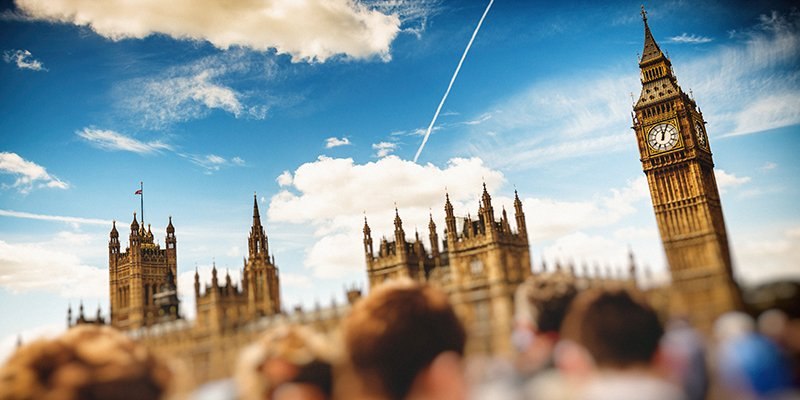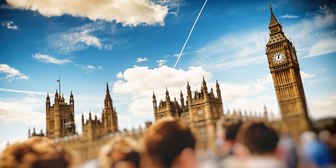Our first MRP projection of the 2024 British general election suggests that Keir Starmer could be heading to Downing Street with a historic majority of 194 seats. With a central projection of 422 Labour wins, this result would be beyond landslide territory. Not only would Starmer’s majority be bigger than the number Tony Blair achieved in 1997 (179), but it would in fact be the second largest majority in British political history after Stanley Baldwin’s figure of 210 in 1924.
The Conservatives would be reduced to 140 seats, according to our model today. That would be their worst performance at a British general election for the party since 1906 – the first election where the Labour Party, then led by another Keir (Hardie), went into double-digit seat wins (27).
The model, which uses survey data from almost 60,000 respondents, is designed to tell us what would happen if the general election were happening right now, with people’s vote intention (or lack of) as it currently stands. It is not a forecast, but is designed to give a detailed, seat-by-seat look at the British political landscape as we head toward 4 July.
The model suggests that the Conservatives could be set for near wipeout across many areas of the country, including London, the North East, the North West, and Wales. It also projects that the Scottish National Party would lose more than half their seats, with Labour returning as the largest party north of the border.
The Liberal Democrats would supplant the SNP as the third party of British politics, taking back that particular crown for the first time since 2010. With 48 seats in this model, Ed Davey appears to be successfully guiding his party back to having a significant presence in the House of Commons once more.
Elsewhere, we are projecting that the Greens would win a second Westminster seat for the first time in their history, in Bristol Central, that Plaid Cymru would also win two seats, and that Reform UK would come away as it stands empty handed.
If these results were indeed replicated on polling day, it would be a seismic shift for British politics, with Boris Johnson’s “one seat for every day of the year” thumping 2019 majority long a distant memory.
Key figures losing their seats
Today’s MRP data shows that whilst some key positions in the current government’s cabinet look set to held by the Conservatives, others are not as fortunate.
The seats of Godalming and Ash, being contested by Jeremy Hunt, Cheltenham (by justice secretary Alex Chalk) and Chippenham (by science secretary Michelle Donelan), are currently due to switch over to the Liberal Democrats. Cheltenham would subsequently be seen as a safe Lib Dem seat if the current results come to pass. Education secretary Gillian Keegan’s Chichester seat will also be a closely fought contest between Conservatives and Liberal Democrats.
Of the Conservative MPs standing down this year, Lib Dems look likely to take Esher and Walton (Dominic Raab’s old constituency) and there will be strong competition in the seats being vacated by Theresa May (Maidenhead) and Michael Gove (Surrey Heath), both currently a toss-up between the blue and yellow sides.
Grant Shapps’ seat in Welwyn Hatfield is currently touted as a likely Labour seat, with further competitions from Labour in Portsmouth North (Penny Mordaunt’s seat), Central Devon (Mel Stride), Forest of Dean (Mark Harper), and Monmouthshire (David T C Davies).
Labour continues to benefit by taking former Prime Minister Boris Johnson’s seat in Uxbridge and South Ruislip which, at the moment, is likely Labour. Of those in the shadow cabinet, just Bristol Central looks like a possible defeat (going to the Greens) whilst the rest are currently safe Labour.
Which seats are on a knife-edge?
According to our model, 131 seats are currently a tossup – that is to say that the winning party’s lead is fewer than five points. This includes one three way marginal: Frome and East Somerset, which sees the Conservatives, Labour and Lib Dems all on 25-30% of the vote.
Eighty seven of these seats are contests between the Conservatives and Labour; the Tories are in the lead in 50 and Labour in 37. The way in which these eventually fall could take the edge off Conservative defeat or reinforce Labour dominance.
It’s also worth noting that the margin of error varies from seat to seat. We provide upper and lower figures along with error bars on the interactive MRP map on our election hub.
The average error of a seat will increase when there are specific local factors at play that are difficult to fully account for in our model. It is worth noting that at this point our model does not take into account specific individual candidacies, as the finalised candidates’ lists have not yet been published. This means that the results in seats with strong independent candidates – like Islington North where Jeremy Corbyn is standing or Rochdale which George Galloway took in February – will not reflect that variable in this particular model. Once the candidates’ lists have been published, our subsequent MRP releases will take these considerations into account.
The Greens
Whilst we do not know final numbers yet, the Green Party are already standing a record number of candidates for this election. They also go into the vote having had their best-ever local election results last month, increasing the number of seats they hold by over 240.
Our MRP model has the Greens winning two seats, their highest total to date, holding onto Brighton Pavilion and gaining a seat in Bristol Central from Labour.
We also find them coming second in a further 46 seats, mainly across London and the North West. They also come second in the Bristol East constituency, neighbouring Bristol Central. However, all of these seats are deemed ‘safe’ for Labour, with the party taking at least double the vote share of Greens even in the ones they perform best in.
Reform UK
Our model shows Reform UK performing strongly in a number of seats but still a long way off winning in any. Our current model puts the right-wing party in second place in 27 seats, including eleven seats in Yorkshire (e.g. Barnsley North, Barnsley South, Doncaster North) and eight in the North East (e.g. Hartlepool, Houghton and Sunderland South).
Prior to dissolution, Reform UK had one seat following the defection of Ashfield MP, Lee Anderson, from the Conservative party. Here, our model suggests Labour will win back the seat they lost in 2019, with the Conservatives and Reform UK fighting for second place. The fieldwork for the MRP was completed before Nigel Farage confirmed he would stand for Reform UK, so does not reflect any impact that may make.
In 2019 the Brexit Party stood down in all Conservative held seats as part of a pact between the two parties. No such pact is in place this election, which begs the question of how much Reform UK are hurting the Conservative Party. If the party were to stand aside in all seats and their voters moved exclusively to the Conservatives then this would constitute a lot of gains for the Tories, however, analysis here suggests that just three in ten Reform UK voters would likely vote Conservative if their party was not standing.
If we applied this more conservative estimate uniformly across all seats then we find that Reform UK standing could be costing the Conservatives 16 seats. These are all seats where the Labour vs Conservative race is already on a knife edge such as Chatham and Aylesford, Bridgwater, and West Suffolk. Of course, this is a fairly crude calculation and assumes Reform UK voters would act the same way across the country. Of course, it is nigh on impossible to predict accurately the impact of this a hypothetical scenario.
The Liberal Democrats
Our model has the Liberal Democrats winning 48 seats – more than four times their 2019 tally, and almost identical to the number they won 1997 (46, although still below the party’s high watermark of 62 in 2005).
This marks the return of the Liberal Democrats to the position of the third largest party in the Commons.
Based on nominal 2019 results, all Lib Dem gains are taken from the Conservatives.
The Lib Dems have historically performed well in the South West, and this election sees them take 14 seats in the region –the same as they did in 1997. Unlike in 1997, however, the party has made significant gains in the South East, winning 17 seats there according to our model. Overall, 36 of the Lib Dems’ 48 seats are in the South outside of London – increasing to 42 if the capital is included.
One seat that our model suggests could switch to the Lib Dems is Chichester, currently held by Conservative Education secretary, Gillian Keegan. If this seat were to switch to the Lib Dems it would be the first time the Conservatives haven’t held the seat since 1865.
Scotland
According to our model, Labour will be the largest party in Scotland by some margin. Our seat totals have Labour taking 34 seats, the SNP 17, the Conservatives five and the Lib Dems one. This is the best Labour seat haul in Scotland since the 2005 and 2010 general elections, at both of which it won 41 seats.
Even for an election with such a dramatic change in the composition of the House of Commons, the churn in Scotland is very large. Of Scotland’s 57 seats, 35 seats are changing hands according to our model – 61% of all seats. This compares to 41% of seats in England.
Scotland is also notably more marginal than England – on average the winning party’s lead is eight points in Scotland compared to 23 points in England. Twenty seats – more than a third of the total – are toss ups; in all twenty the SNP are one of the two parties vying for the top spot, with Labour the other party in 17 cases.
Having swept Glasgow in 2015 and 2019, and having won all but one seat there in 2017, the SNP could be entirely ejected from Scotland’s largest city in July. Labour take all six Glasgow constituencies under our model – although two (Glasgow North and North East) are tossups.
There are two important things to note when comparing Scottish data from this MRP to our previous, non-election campaign, models. Firstly, this is the largest Scottish sample that YouGov have used for an MRP since the 2019 general election. This gives us much more detail in terms of what is happening seat to seat. As well, we have been able to update some of the MRP target data with newly released 2022 Scottish census data.
Wales
With the new boundary changes Wales will be dropping from 40 seats to 32 seats after the general election, and our model has Labour winning 28 of them. This would be an increase on the 22 they won last time and a significant improvement on the 18 they could have expected to win in 2019 had the current boundaries been in place at that time. All of these wins are at the expense of the Conservatives who would only keep hold of Montgomeryshire and Glyndwr, and Brecon, Radnor and Cwm Tawe – neither of which are safe.
A number of the Conservative losses are in traditional Labour areas that went Conservative at the last election such as Wrexham and Bridgend. The Conservative held Ynys Mon that they won in a three-way battle again Labour and Plaid Cymru last time is likely to just be a two-way fight this time between Labour and Plaid.
Plaid Cymru would win two seats at this election based on our model, down from the four they won in 2019 under the old boundaries. The Liberal Democrats are unlikely to win a seat in Wales but could push the Conservatives in Brecon, Radnor and Cwm Tawe.
Revival of the Red Wall
Our model shows the Red Wall being completely repaired at the coming election. Of the 42 successor seats to those identified as forming the Red Wall in 2019, all are now won by Labour, all bar two by double-digit margins. The Conservatives are pushed back into second in most seats except three in which Reform UK garner more votes: Ashfield, Normanton and Hemsworth, and Ellesmere Port and Bromborough. In none do the Conservatives take more than 34% of the vote.
Fall of the Blue Wall
Earlier in the Parliament, we identified a swathe of vulnerable Conservative seats across the South, which we dubbed the Blue Wall. These were seats that had voted to Remain in 2016 and had a higher than average concentration of graduates.
Following the boundary changes, there are 45 successor seats to this grouping. We can see that Labour have returned the favour of 2019 to the Conservatives, taking their own sledgehammer to the Tory bedrock. Our model has 19 of these seats going to Labour, with a further 13 picking a Liberal Democrat MP. Only 13 remain in Conservative hands.
London
The Conservatives are at risk of being ejected from London entirely. Our model currently has the Tories taking only four seats in the capital, but all four are close contests.
With Sadiq Khan having secured the London mayoralty for a third term a couple of months ago, Labour are set to take 65 of the capital’s 75 seats. This includes the successor seat to Boris Johnson’s constituency, Uxbridge and South Ruislip, which Labour wins with a 16-point lead.
The Lib Dems are set to take six seats, including Wimbledon in a relatively close three-way race which sees Ed Davey’s party on 35% versus the Conservatives and Labour both on 28%.
English regions
Labour is now the largest party in the South of England, a feat it did not accomplish even in its 1997 landslide victory. In the South outside of London, Labour take 88 seats to the Conservatives’ 85, with the Lib Dems taking a further 36. By contrast, in 1997 the Conservatives still took 109 southern seats outside of London to Labour’s 59.
If we include London then Labour’s southern tally rises to 153, while the Tories’ total barely budges to 89. In 1997, parties had been neck and neck, with the Conservatives on 120 and Labour winning 116 seats.
While otherwise not a new experience for Labour, it is also the largest party in every region of England outside of the South, as well as Scotland and Wales.
What do you think about a Labour landslide, the election campaign, and everything else? Have your say, join the YouGov panel, and get paid to share your thoughts. Sign up here.
Photo: Getty













